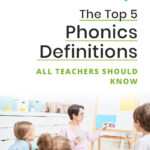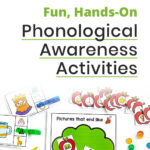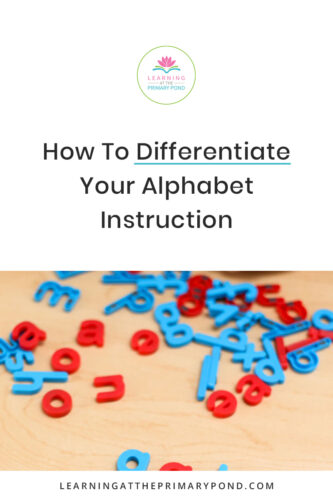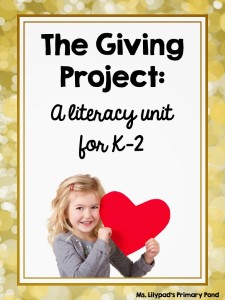Phonemic awareness is the awareness of individual speech sounds, like the /p/ sound in “park” or the /sh/ sound in “dish.” It also includes the ability to work with those sounds – for example, switching out the /m/ in “mat” to be a /p/ and make the word “pat.” Many phonemic awareness activities are teacher-led. But are there phonemic awareness activities that young learners can work on independently – like in small groups or centers, for example?
Yes – absolutely! There are plenty of easy phonemic awareness activities that students can do on their own. Keep reading for tons of ideas for engaging, hands-on phonemic awareness activities. These activities are a great way for young children to get further practice with the essential skills you’re already teaching and working on during teacher-led instruction.
In this blog post, in addition to showing 5 easy-to-use phonemic awareness activities, I’ll also explain why phonemic awareness matters for students! All the resources in this post come from my hands-on phonemic awareness activities, which you can learn more about here.
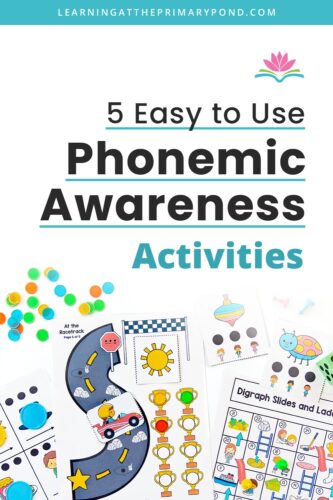
Why Should I Include Phonemic Awareness In My Instruction?
Before I get to the activities, let’s talk about why phonemic awareness matters. Here’s why:
- Phonemic awareness helps students learn phonics. Phonics = the relationships between sounds and letters/letter combinations.
- Learning to read requires skills that the brain is not “wired” for. Kids have to learn to pay attention to the individual sounds (phonemes) in words, so that they can learn how these sounds are represented with letters. Phonemic awareness activities build this awareness and skill set.
- Proficiency in phonemic awareness contributes to success in decoding (word reading). As students’ decoding progresses, so does their fluency – the ability to read smoothly and with expression. With improved fluency, students can focus on understanding the meaning of the text, leading to improved comprehension.
- Strong phonemic awareness can also help with encoding (spelling). When students can isolate and segment phonemes, this serves as a strong foundation for learning how those sounds are represented with letters and letter combinations. (For instance, if a student can segment the word “dig” into its word parts of “/d/, /ĭ/, /g/” orally using elkonin boxes / sound boxes, then the student can also learn how to use written letters that make the sounds “/d/, /ĭ/, /g/ to spell the word.”) Phonemic awareness is crucial for accurate and confident spelling, a key component of effective and fluent written communication.
- Phonemic awareness is often a key indicator or predictor of a child’s future success in reading. Identifying challenges in this area early on allows for targeted interventions if necessary. This can sometimes prevent reading difficulties from escalating. Early intervention is crucial in ensuring that children develop strong foundational skills.
Phonemic awareness is part of phonological awareness, the broader category which focuses on the sound structures of language. Pure phonological awareness does not involve letters or print of any sort. Some phonological awareness skills include:
- Identifying the individual words in a sentence spoken aloud
- Identifying and generating rhyming words
- Separating words into onset and rime and combining onsets and rimes into words
- Separating words into syllables and blending syllables together to make words
- All phonemic awareness skills and subskills
To align with the Science of Reading research, I recommend covering phonological / phonemic awareness daily, through explicit instruction. (To learn more about the terms, check out the blog The Top 5 Phonics Definitions All Teachers Should Know.)
What Are the Six Levels of Phonemic Awareness?
There are many different skills within the category of phonemic awareness instruction. They include:
- Isolating sounds
- Blending sounds
- Segmenting sounds
- Adding sounds
- Deleting sounds
- Substituting sounds
Examples of Phonemic Awareness Skills
Isolating: Even though isolating sounds is considered the “easiest” skill, there are still levels of difficulty within this step:
- Children usually begin by learning to say the first sound in a word. For example, they might identify the first sound in the word “fun” as /f/. If that’s still too difficult, you might try having students match pairs of pictures that begin with the same sound (without asking them to identify that sound yet).
- Eventually, children learn to isolate the final letter sound in a word (i.e. /t/ in “pat”) and medial vowel sounds (i.e. /ĭ/ in “lip” or the long a sound in “pail”)
Blending: This is when we say sounds aloud and students say the entire word. If we say /ŭ/ /p/, students must blend those sounds together and say the whole word: “up.” Again, there are different levels of difficulty within the category of blending. You might start with small words like “at” and “go,” progress to 3-sound words, and eventually incorporate more challenging sounds like digraphs, blends, and diphthongs.
Segmenting: Phoneme segmentation is when we say a given word (i.e. “trap”) and students tell us the sounds (/t/ /r/ /ă/ /p/). Just like with blending, different types of words can be more or less challenging for students to segment.
With the next 3 levels, we’re moving into phoneme manipulation, which includes adding, deleting, and substituting phonemes.
Adding Phonemes: This means having students orally add a sound to a word. We might say “The word is ‘at.’ Add /s/ to the beginning, and we get…” (sat) You can have students add phonemes to the beginning or end of words.
You can even have students insert a phoneme after the first sound to make a word with a consonant blend: “The word is tip. Tip, add /r/ after /t/, and we get…” (trip) Of course, this is challenging for many young students!
Deleting Phonemes: As it sounds, this is deleting or removing a phoneme. Example: “The word is ‘Bake.’ Bake, take away /k/, and we get…” (bay) Notice that the actual spelling of the word does not matter in this case – it’s about the sounds.
Phoneme Substitution: This is when you’re switching out a sound in a word to make a new word. You might say, “The word is bat.’ Say /ĕ/ instead of /ă/ and we get…” (bet). Here, you’re having students swap out the middle sound. You can do this with initial sounds or ending sounds, too!
5 Easy to Use Phonemic Awareness Activities
Before we get into the activities, I want to mention that students should be proficient with a phonemic awareness skill before you assign independent practice to them! This ensures that students are successful with the activities and makes it more likely that they will practice correctly – which is, of course, what we want.
Activity 1: Tic-Tac-Toe
Students play this game with a partner. Player 1 chooses a picture on the board and says the individual sounds for the word by touching one dot per sound. (For instance, for the picture of a “nut,” the student would touch each dot, saying /n/ /ŭ/ /t/.) Then the player would slide their finger along the arrow to blend those sounds together to produce the entire word (“nut”).
Once Player 1 blends the word, they can add a chip on top of the picture. Player 2 then takes a turn. Students are trying to get 3 in a row to win. If no one gets 3 in a row, they can remove all the chips and start again! You could have students play again on the same board for practice or have them choose a new board each time. There are CVC words and digraph word options included.
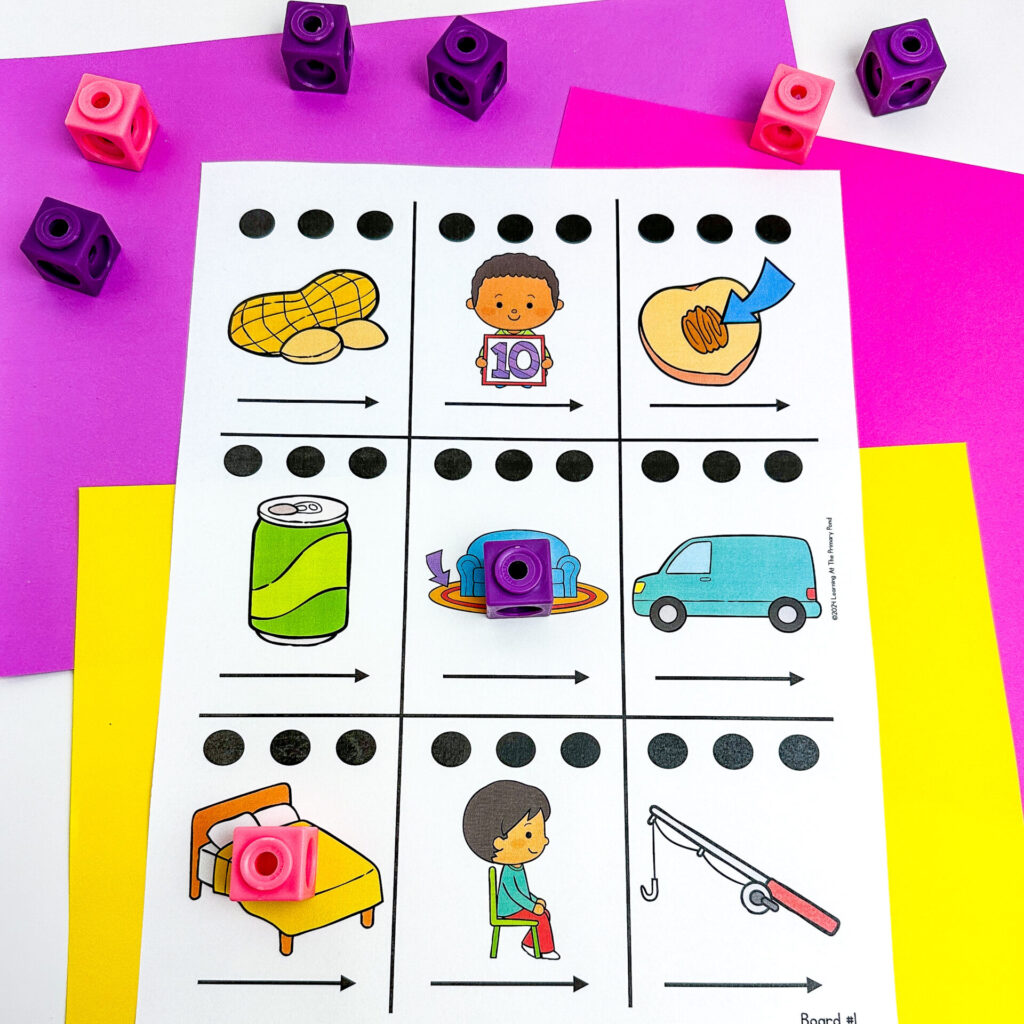
Activity 2: Segmenting Action Cards
Students can do this activity independently. Students will choose a card and say the picture’s name. Then students will segment the word into its individual sounds while doing each action pictured below the dot. For example, if students have a card with a picture of a web, they would say, “web,” then put their hands in the air and say, /w/, lower their arms a bit and say, /ĕ/, and put them all the way down to their sides and say /b/.
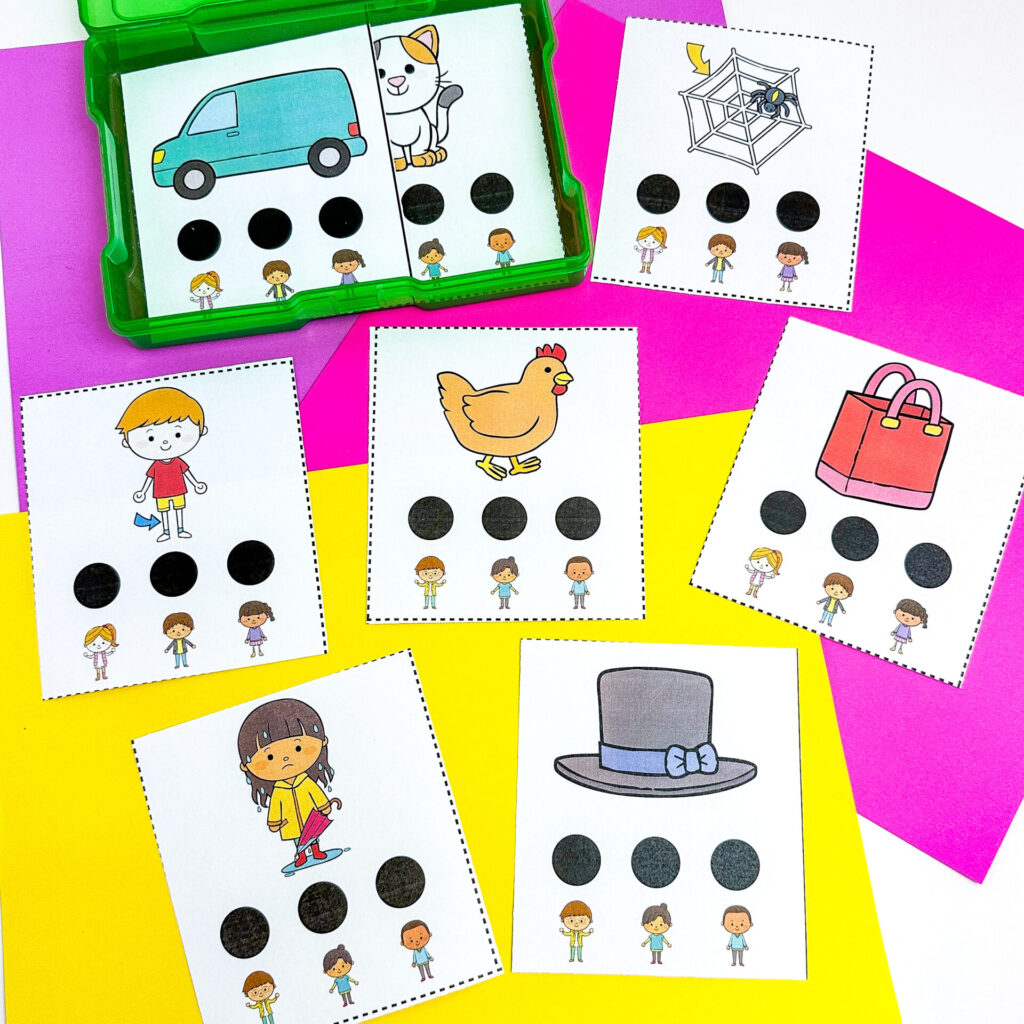
Activity 3: Digraph At the Beach/CVC At the Racetrack
This activity can be done independently or in partners. There is a digraph version called “At the Beach” and a CVC version called “At the Racetrack.” (Here are the directions for “At the Beach,” but the Racetrack version is similar!)
Students will choose a picture card and place it in the box by the beach on the “At the Beach” board. Then, they’ll say the picture name on the card. While moving their surfer along the stream, students will segment the word into its sounds by saying one sound at each part of the stream.

Example: For a card with a picture of a chip, students would say /ch/ while they are “surfing” in the first segment of the stream, /ĭ/ while “surfing” in the second segment, and /p/ while “surfing” in the third segment of the stream.
When students get to the beach, they should blend the sounds together to say the entire word. After they blend the sounds to make the word, they get to put a chip on an item they would want at the beach. Students should try to earn as many beach items as they can.
Activity 4: Roll-and-Race
Students can do this activity independently. Tell students that the drivers are going to race to see who is the fastest. Students roll the die. They find the driver with the corresponding number rolled and say the beginning/middle/end sound (depending on which board the student is using) of the first picture in that row.
For example, if a 2 was rolled on the beginning sound board, a student would find Driver 2, look at the first picture which is a sun, and say, “/s/.” After the /s/ for ‘sun’ is stated, students would cover that sun picture with their chip/counter. If a 2 is rolled again, students would go to the next picture in the row (fan) and say the beginning sound. Have students continue to roll and say the first sound of the picture in the row they rolled. The driver whose row of pictures is covered first “wins” the race.
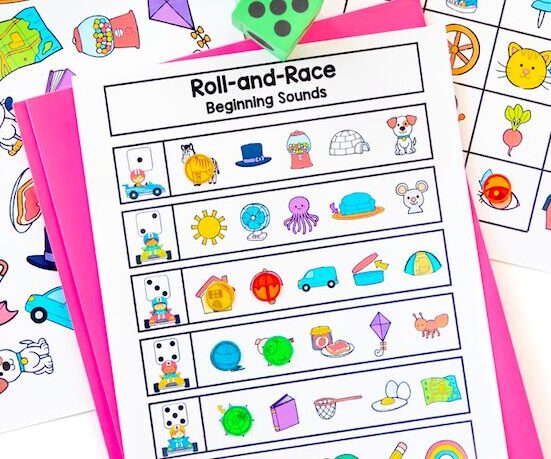
Activity 5: I Spy
Students can do this activity with partners. Partners will share the Picture Cards, but each student will need their own I Spy Board. This game has variations for beginning, middle, and ending sounds included.
Students will mix up the picture cards and place them in a pile, facedown. Player 1 will flip over the top card. Together, Player 1 and Player 2 must say the name of the picture and the middle sound (for the middle sound game) of the word.
For example, if Player 1 flips over a card with a picture of a mop, both players will say, “mop, /ŏ/.” Then each player will look over their own board to find another picture that has the same middle sound. They need to try to point to the picture as quickly as they can. Whoever finds and says the picture name and middle sound first gets to keep the card.
Using the mop example above, the player who finds, points to, and says (for example), “fox, /ŏ/“ first will keep the mop card. Then Player 2 will flip over the next picture card on the pile and play continues. The player with the most cards at the end of the game wins.

Conclusion
Using any phonemic awareness activity to practice and review is such a fun way to make these concepts “stick” for students! To learn more about these resources highlighted above, click HERE.

The hands-on activities can be used for Kindergarten students or 1st grade students who are beginning to learn these concepts. However, the activities can also be used with older students – even 2nd grade or 3rd grade students – who are in need of extra phonemic awareness practice. (Many struggling readers have difficulty with phonemic awareness skills.)
Any of these resources could be used for independent work, in a small group setting, or even placed in intervention binders to have on hand when you’re in need of different phonemic awareness activities.
Happy teaching!


